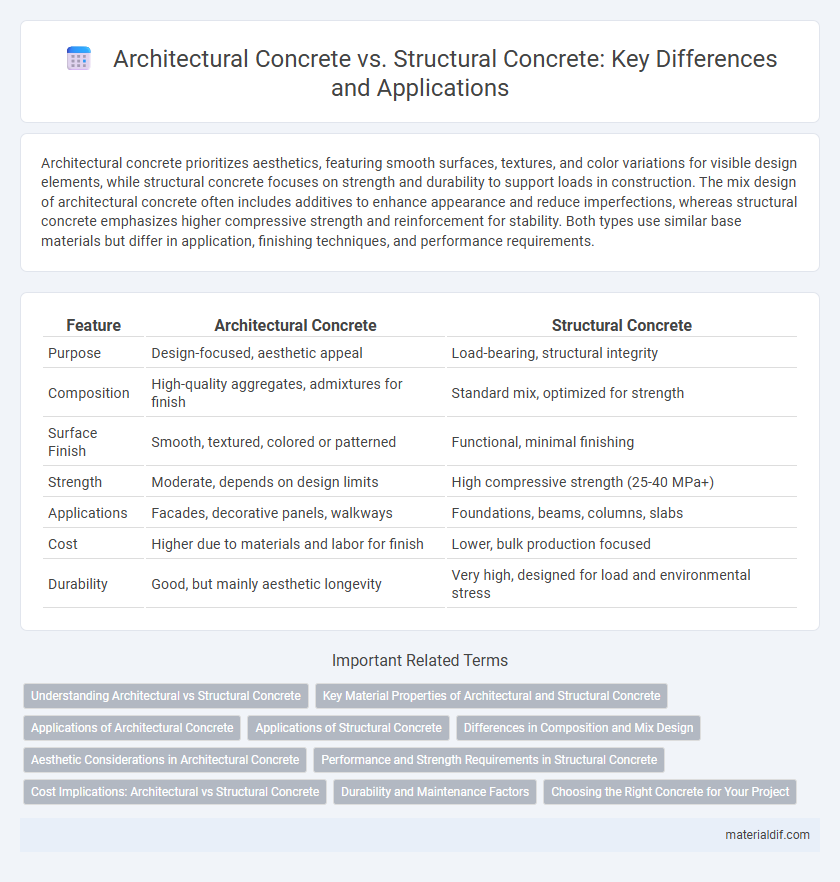Architectural concrete prioritizes aesthetics, featuring smooth surfaces, textures, and color variations for visible design elements, while structural concrete focuses on strength and durability to support loads in construction. The mix design of architectural concrete often includes additives to enhance appearance and reduce imperfections, whereas structural concrete emphasizes higher compressive strength and reinforcement for stability. Both types use similar base materials but differ in application, finishing techniques, and performance requirements.
Table of Comparison
| Feature | Architectural Concrete | Structural Concrete |
|---|---|---|
| Purpose | Design-focused, aesthetic appeal | Load-bearing, structural integrity |
| Composition | High-quality aggregates, admixtures for finish | Standard mix, optimized for strength |
| Surface Finish | Smooth, textured, colored or patterned | Functional, minimal finishing |
| Strength | Moderate, depends on design limits | High compressive strength (25-40 MPa+) |
| Applications | Facades, decorative panels, walkways | Foundations, beams, columns, slabs |
| Cost | Higher due to materials and labor for finish | Lower, bulk production focused |
| Durability | Good, but mainly aesthetic longevity | Very high, designed for load and environmental stress |
Understanding Architectural vs Structural Concrete
Architectural concrete is primarily designed for aesthetic appeal, featuring smooth finishes, unique textures, and color variations that enhance a building's exterior or interior appearance. Structural concrete, in contrast, focuses on strength, durability, and load-bearing capacity, forming the core support elements such as beams, columns, and foundations. Understanding these differences ensures the appropriate selection of concrete type to meet both visual design goals and structural safety requirements.
Key Material Properties of Architectural and Structural Concrete
Architectural concrete prioritizes surface aesthetics, featuring enhanced finish quality, color consistency, and texture control, while maintaining adequate strength for design purposes. Structural concrete emphasizes compressive strength, durability, and load-bearing capacity to safely support building loads and resist environmental stresses. Key material properties for architectural concrete include workability and visual appeal, whereas structural concrete focuses on high compressive strength, toughness, and long-term durability.
Applications of Architectural Concrete
Architectural concrete is primarily utilized for aesthetic elements in facades, decorative panels, and interior wall finishes, enhancing visual appeal while maintaining durability. Common applications include precast cladding, exposed aggregate surfaces, and intricate moldings that require precise texture and color control. This type of concrete supports design innovation in commercial buildings, public spaces, and residential projects by combining functionality with artistic expression.
Applications of Structural Concrete
Structural concrete is primarily used in the construction of load-bearing elements such as beams, columns, slabs, and foundations, providing essential strength and stability to buildings and infrastructure. Its applications include bridges, high-rise buildings, dams, and tunnels where structural integrity and durability under heavy loads are critical. This type of concrete is engineered to withstand compressive forces, ensuring safety and longevity in complex construction projects.
Differences in Composition and Mix Design
Architectural concrete incorporates fine aggregates and specially selected pigments or admixtures to achieve aesthetic finishes, often emphasizing surface texture and color uniformity, while structural concrete prioritizes strength and durability using larger aggregates and higher cement content to meet load-bearing requirements. The mix design for architectural concrete typically involves lower water-cement ratios and additives to enhance workability and minimize surface imperfections, contrasting with structural concrete's formulation focused on compressive strength and resistance to environmental factors. Variations in aggregate size, admixtures, and cement type distinctly differentiate the compositions tailored for visual appeal versus mechanical performance in these concrete types.
Aesthetic Considerations in Architectural Concrete
Architectural concrete emphasizes aesthetic considerations such as texture, color, and finish to enhance visual appeal, often incorporating form liners and pigments for customized designs. Its surface treatments include polishing, stamping, and exposed aggregate techniques to create decorative effects, distinguishing it from structural concrete's primary focus on strength and durability. The integration of architectural concrete in building facades and interior elements supports creative expression while maintaining functional performance.
Performance and Strength Requirements in Structural Concrete
Structural concrete is engineered to meet rigorous performance and strength requirements, ensuring load-bearing capacity and durability under stress conditions. It typically undergoes stringent quality control measures, including precise mix design and curing processes, to achieve high compressive strength often exceeding 4,000 psi. Unlike architectural concrete, which prioritizes aesthetic finish, structural concrete emphasizes mechanical properties and long-term stability to support structural integrity in construction projects.
Cost Implications: Architectural vs Structural Concrete
Architectural concrete generally incurs higher costs due to specialized finishes, molds, and labor required for aesthetic purposes, whereas structural concrete prioritizes strength and durability, allowing for more cost-effective production methods. The use of decorative aggregates, pigmentation, and surface treatments in architectural concrete increases material and labor expenses compared to the functional, load-bearing nature of structural concrete. Budget considerations must account for the distinct purposes: architectural concrete enhances visual appeal, demanding higher investment, while structural concrete focuses on cost-efficiency and performance under load.
Durability and Maintenance Factors
Architectural concrete emphasizes aesthetic appeal while maintaining durability through the use of high-quality aggregates and surface treatments, reducing the need for frequent maintenance. Structural concrete prioritizes strength and load-bearing capacity, with durability enhanced by proper mix design and curing to resist environmental stresses like corrosion and freeze-thaw cycles. Maintenance requirements for architectural concrete focus on preserving surface finish, whereas structural concrete demands regular inspection to ensure structural integrity over time.
Choosing the Right Concrete for Your Project
Architectural concrete prioritizes aesthetics, featuring smooth finishes, colors, and textures to enhance visual appeal, making it ideal for facades and decorative elements. Structural concrete emphasizes strength and durability, designed to withstand heavy loads and environmental stresses in foundations, beams, and columns. Selecting the right concrete depends on project goals, balancing appearance needs with structural requirements for optimal performance.
Architectural Concrete vs Structural Concrete Infographic

 materialdif.com
materialdif.com